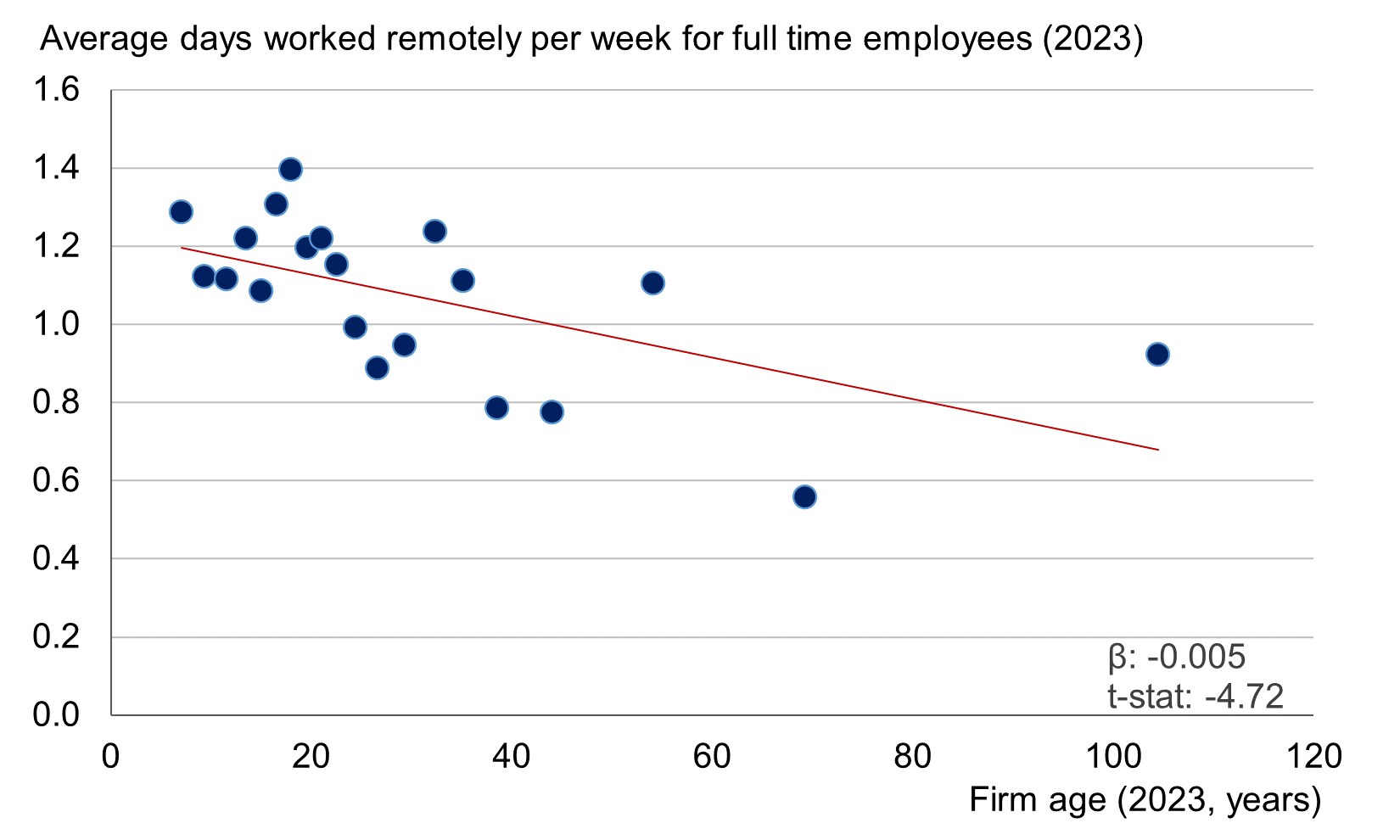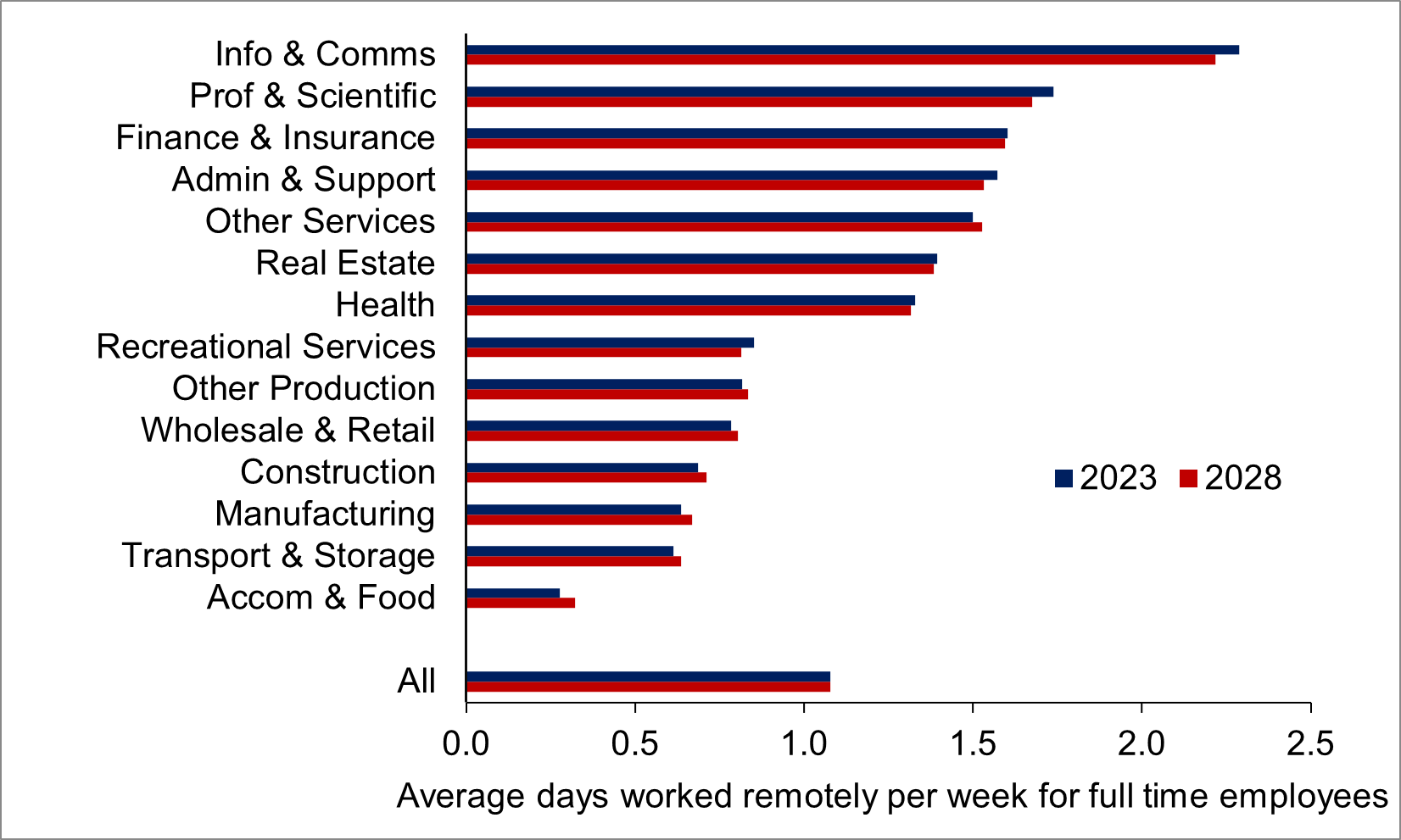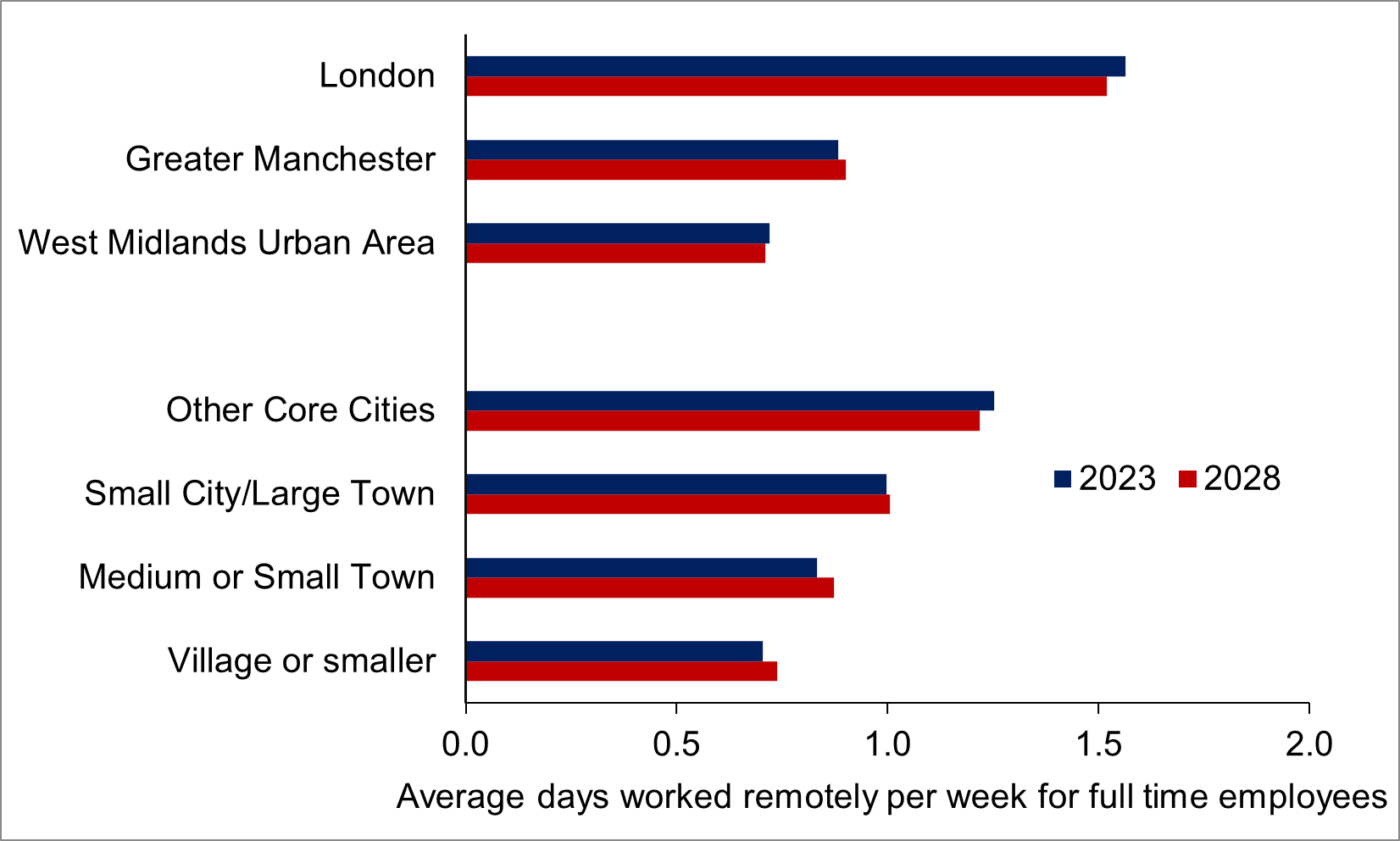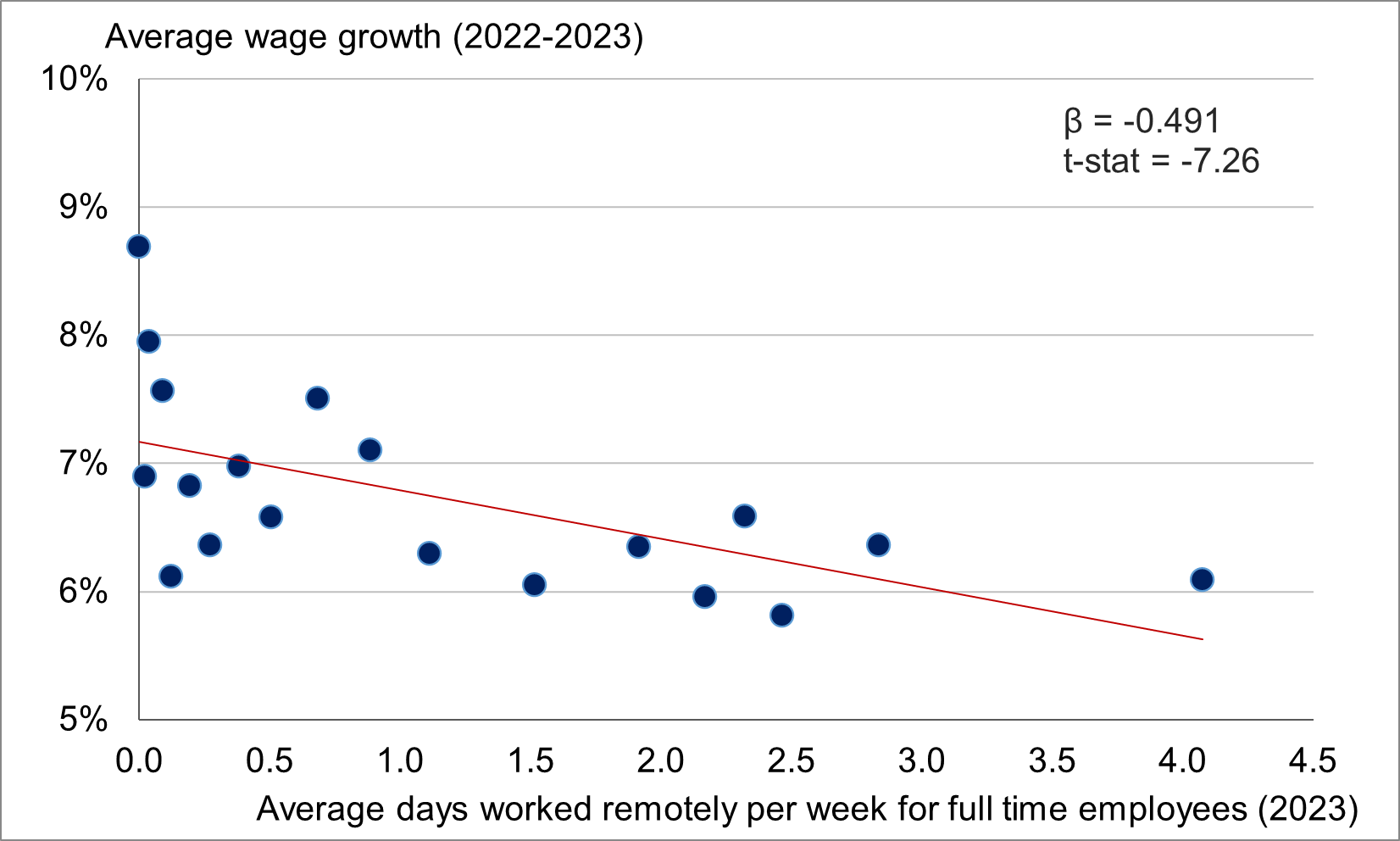New data from a 2,500 firm survey show how UK managers expect working from home to stay. They forecast levels of remote work in 2028 within their own firms that are almost identical to the levels in 2023. But aggregate working from home could still increase as younger firms tend to make more use of remote working, and they are likely to grow more quickly in the future. Matching this survey data to detailed firm accounts data, we find that firms with higher levels of working from home have higher productivity and lower wage growth.
Working from home is likely to remain an important feature of the labour market
The Decision Maker Panel (DMP) is jointly run by the Bank of England, Stanford University, King’s College London, and the University of Nottingham and surveys the chief financial officers of around 2,500 UK firms each month. The DMP is unique in providing insight into firms across a broad range of sectors. The August to October 2023 waves of the survey asked firms “approximately what percentage of your full-time staff fall into the following categories [onsite, hybrid, fully remote] both now and five years ago? And what proportions will be in each category in 2028?”.
Senior firm leaders expect remote working to remain an important feature of the labour market: firms reported that in 2018 just under 6% of their employees worked hybrid and just under 4% of their employees worked fully remote. In 2023, these numbers had risen to 30% and just under 8%, respectively. In 2028, firms expect these proportions to remain stable with a slight fall in hybrid and a small increase in those working fully remote (Figure 1). Previous DMP questions suggest that hybrid workers spend around half of their time working from home. That implies that an average of just over 20% of overall employee days, or just over 1 day a week for full-time employees, are spent working from home in 2023. A similar proportion is expected for 2028. The large adjustment in working arrangements since the pandemic is here to stay, consistent with evidence from the US (Bloom et al. 2023).
Figure 1 Proportion of full-time employees based fully onsite, hybrid or fully remote in 2018, 2023 and expected in 2028
Notes: Based on question: “Approximately what percentage of your full-time employees fall into the following categories, both now and five years ago, back in 2018? And what proportion will be in each category in 2028?” N = 2,274 firms.
Although Figure 1 suggests little change in remote working within firms over the next five years, these estimates are likely to represent a lower bound. This is for two reasons. Firstly, the number of days that hybrid workers do off-site may increase. Firms in the DMP have previously reported that, in 2019, the majority of hybrid workers (54%) worked only one day out of the office, by 2022 only 21% of hybrid workers spent one day remote, while 37% spent two days out of the office and 30% worked remotely for three days. Should the pattern of more intensive remote working for hybrid employees continue, then total days worked remotely will increase.
Second, there may be dynamic effects as new/younger and faster growing firms are more likely to embrace remote working. Figure 2 shows that there is a strong relationship between firm age and the average number of days worked remotely by employees in 2023, with employees in younger firms working significantly more days offsite. Young firms tend to grow more quickly than older more established firms, and assuming that continues to be the case and their higher use of remote working reflects a cohort effect, the prevalence of remote working across the economy as a whole could continue to increase in the future as these younger firms make up a growing share of the economy. A thought experiment, assuming that all firms in the DMP grow at the same rate in the next five years as they did in the previous five years, suggests that total remote days worked in 2028 could be up to 18% higher than if firm sizes are held fixed (as is the case in Figure 1).
Figure 2 Firm age and the average number of working days done remotely per week, 2023
Notes: Binned scatter plot where each dot represents 5 percent of observations, grouped by firm age. Average days worked remotely are based on question: “Approximately what percentage of your full-time employees fall into the following categories, both now and five years ago, back in 2018? And what proportion will be in each category in 2028?”. See methodology box for more detail on how the distribution of days worked remotely by hybrid workers is calculated. Firm age is derived by deducting the year of incorporation from the Bureau van Dijk FAME database from 2023. N = 2,253 firms.
There is significant industrial and geographic variation in working from home
Looking across industries in Figure 3 confirms the findings of previous studies which have looked at how the ability to work from home during the pandemic varied across industries and occupations (Dingle and Neiman 2020, Adams-Prassl et al. 2020). It shows that the average days worked remotely per week, both now and expected in the future, are highest in the business services sectors such as information and communications, professional and scientific activities, and finance and insurance, which are often jobs paying higher wages than the economy-wide average. These workers often undertake computer-intensive tasks which can be easily conducted remotely, and given their higher incomes typically have larger residences which can accommodate homework. By contrast, the prevalence of working from home is low and expected to remain low in accommodation and food services, and in the transportation and storage sector both of which require physical interaction with customers or facilities. The relatively modest changes in the expected number of days worked remotely in 2028 indicates that firms do not expect new innovations which fundamentally change the optimal level of remote working for their businesses.
Figure 3 Average number of working days done remotely per week, by industry
Notes: Average days worked remotely are based on question: “Approximately what percentage of your full-time employees fall into the following categories, both now and five years ago, back in 2018? And what proportion will be in each category in 2028?”. See methodology box for more detail on how the distribution of days worked remotely by hybrid workers is calculated. N = 2,274 firms.
Unsurprisingly, given the industries which are most conducive to remote working arrangements, a greater number of days are worked remotely in firms headquartered in urban areas, where business services activities are most likely to take place. Figure 4 illustrates that on average 30% of the week is worked remotely by employees in firms headquartered in London, while across all other Core Cities roughly a quarter of total employee days are worked from home. By contrast in small towns and villages only around 15% of employee days are remote. This spatial pattern supports work which points to the trade-off between the opportunity cost of fewer face-to-face interactions and the cost and time-spent travelling as determining the extent to which cities see reduced footfall in their central business areas: with larger more congested settlements seeing greater use of remote working arrangements (Monte et al. 2023, Bond-Smith and McCann 2022, Barrero et al. 2023).
Figure 4 Average number of working days done remotely per week, by city and broad settlement type
Notes: Average days worked remotely are based on question: “Approximately what percentage of your full-time employees fall into the following categories, both now and five years ago, back in 2018? And what proportion will be in each category in 2028?”. See methodology box for more detail on how the distribution of days worked remotely by hybrid workers is calculated. Firm location refers to the location of its headquarters. Settlement types are taken from Baker (2018) “City & Town Classifications of Constituencies and Local Authorities”, House of Commons Library. City definitions are provided by Urban Audit Functional Urban Areas (2016). N = 2,158 firms. (London = 705, GM = 65, WMUA = 58).
Benefits for firms and for workers means that working from home is here to stay
It is clear from the above analysis that firms expect remote working to remain at similar levels to today in 2028, but why is this the case? Barrero et al. (2021) develop several theories which could explain this persistence. Central to the firm side of this is that forced experimentation and investment in new technologies have made working from home more effective than pre-pandemic and have led firms to re-optimise their working arrangements as a result. Previous work has demonstrated that workers in the UK perceive themselves as 2% more productive on average when working from home (Mizen et al. 2021).
In Figure 5, we show that the association between higher productivity and more remote working holds at the firm level. The relationship suggests that for each extra day a firm’s average employee works remotely, that firm’s productivity is around £15,000 higher. Importantly, this relationship is not necessarily causal and, given the productivity data relates to the 2021-22 financial year, may simply reflect the types of firms that make more use of remote working.
The relationship we document is weaker when considering pre-pandemic productivity and remote working arrangements, providing evidence for the idea that the pandemic may have spurred investments and innovations which have facilitated more productive remote working (as seen in patent applications in Bloom et al. 2021). Interestingly, we also do not see any relationship between productivity and the proportion of workers who are fully remote. This suggests that the productivity effects of work from home are complex and vary by the precise nature of working arrangements and the tasks that workers complete.
The literature presents a similarly nuanced picture on the productivity effects of remote working. Several papers find fully remote working is associated with lower productivity due to increase coordination costs and reduced mentoring of less experienced workers (Gibbs et al. 2023, Emanuel et al. 2023). While evidence on hybrid work points to weakly positive impacts on measured productivity and larger positive impacts on perceived productivity and well-being (Bloom et al. 2022, Angelici and Profeta 2023). Other papers show increased remote working may be associated with reduced innovation and idea-generation (Brucks and Levav 2022, Lin et al. 2023), but these findings are task context dependent, and may not be present in hybrid settings where aspects of the innovation process which benefit from face-to-face collaboration can be prioritised for onsite days.
Figure 5 Firm productivity and the number of working days done remotely
Notes: Binned scatter plot where each dot represents 5 percent of observations, grouped by remote working in 2023. Average days worked remotely are based on question: “Approximately what percentage of your full-time employees fall into the following categories, both now and five years ago, back in 2018? And what proportion will be in each category in 2028?”. See methodology box for more detail on how the distribution of days worked remotely by hybrid workers is calculated. Labour productivity data are from 2021-22 financial year data in the Bureau van Djik FAME database (the latest year with complete financial accounts for all firms). Labour productivity is defined as value-added (operating profits plus total labour costs) per employee. The relationship remains positive and significant when controlling for two-digit SIC industry classification (88 Divisions). N = 1,116.
The rise in remote working can also have impacts on workers’ wages. Figure 6 demonstrates that firms making greater use of working from home have had lower average wage growth since 2022, with each extra day worked remotely associated with half a percentage point lower wage growth. This slower wage growth is predicted both by models in which remote work opportunities expand the labour supply for a firm, since they are able to hire from a wider geographical area and are able to attract workers who may have been more loosely attached to the labour market, as well as by bargaining models which suggest that firms will adjust compensation packages as workers benefit from amenity value of more flexible working arrangements. Mizen et al. (2021) finds evidence of this latter channel with novel survey data showing that the average worker values working from home for two days a week as equivalent to a 6% boost to earnings.
Figure 6 Average wage growth between 2022-23 and number of working days done remotely
Notes: Binned scatter plot where each dot represents 5 percent of observations, grouped by remote working in 2023. Average days worked remotely are based on question: “Approximately what percentage of your full-time employees fall into the following categories, both now and five years ago, back in 2018? And what proportion will be in each category in 2028?”. See methodology box for more detail on how the distribution of days worked remotely by hybrid workers is calculated. Wage growth data are from the DMP survey. The relationship remains negative and significant when controlling for controlling for two-digit SIC industry classification (88 Divisions) and wages per worker in financial year 2021-22 in the Bureau van Djik FAME database (the latest year with complete financial data for all firms). N = 2,273.
Collectively, Figures 5 and 6 explain why working from home is popular with firms. It is associated with higher levels of productivity and lower wage growth. Given employees are also keen on working from home, which additionally lowers firms' recruitment and retention costs, this could potentially lead to an increase in profits for some firms.
Conclusions
The Covid-19 pandemic has unleashed a material and persistent change in the working arrangements of firms across the UK. In this column, we show that despite some media coverage to the contrary, firms for the large part see remote work as something that is here to stay. Although there are heterogeneities in the prevalence of remote working across industries and geographies, firms are consistent in believing that levels of remote work will be at least unchanged in 2028. Forced experimentation and investment has meant that higher levels of remote working are now more strongly associated with higher levels of productivity than prior to the pandemic. At the same time, the association between higher remote working and lower wage growth underlines that the ability to work remotely is an amenity that workers value.
Methodology box
In the August to October 2023 waves of the Decision Maker Panel, firms were asked “Approximately what percentage of your full-time staff fall into the following categories [onsite, hybrid, fully remote] both now and five years ago? And what proportions will be in each category in 2028?”. Firms only report the proportions of their full-time workforce who work, hybrid, and fully remote and do not specify the number of days their hybrid workers work from home.
In order to generate a measure of average days worked remotely per week we need to assume the average number of days those hybrid workers work off-site. To do this we use questions that were asked in the DMP during the February to April 2021 waves. In these waves firms were asked “On average, how often did your full-time employees work from home/how often do you expect them to work from home in the following periods? [2019 2021Q1 and 2022+]” and were asked to specify the proportions expected to work 0 to 5 days per week from home.
Using firms’ expectations for the 2022+ period we calculate the average number of days firms report their hybrid workers would work from home for each 1-digit SIC industry and firm size cell. We then apply these averages to the proportions of hybrid workers firms reported in 2023 and 2028 in the August to October 2023 waves and combine with the proportions working fully remotely to calculate the average number of days per week worked from home by the full-time employees of each firm. This calculation is the same for 2023 and 2028 hybrid worker proportions and assumes that there are no changes on the intensive margin over this time period.
All aggregated statistics are calculated using employment and industry shares from the Department of Business and Trade’s Business Population Estimates for the UK and Regions as weighting parameters.
References
Adams-Prassl, A, T Boneva, M Golin and C Rauh (2020), “Work that can be done from home: Evidence on variation within and across occupations and industries”, CEPR Discussion Paper 14901.
Angelici, M, and P Profeta (2023), “Smart-Working: Work Flexibility without Constraints”, Management Science 0(0).
Barker, C (2018), “City & Town Classifications of Constituencies and Local Authorities”, Briefing Paper 8322, House of Commons Library.
Barrero, J M, N Bloom and S J Davis (2021), “Why Working from Home Will Stick”, NBER Working Paper 28731.
Barrero, J M, N Bloom and S J Davis (2023), “The evolution of working from home”, Journal of Economic Perspectives 37(4): 23-50.
Bloom, N, S J Davis and Y Zhestokova (2021), "COVID-19 Shifted Patent Applications toward Technologies that Support Working from Home", American Economic Association, Papers & Proceedings, May.
Bloom, N, R Han & J Liang (2022), “How Hybrid Working From Home Works Out”, NBER Working Paper 30292.
Bloom, N, J M Barrero, S J Davis, B Meyer and E Mihaylov (2023), “Survey: Remote Worker Isn’t Going Away – and Executives Know It”, Harvard Business Review.
Bond-Smith, S and P McCann (2022), “The work-from-home revolution and the performance of cities”, Working Papers 026, The Productivity Institute.
Brucks, M S and J Levav (2022), “Virtual communication curbs creative idea generation”, Nature 605: 102-112.
Dingel, J and B Neiman (2020), “How many jobs can be done at home?”, Journal of Public Economics 189.
Emanuel, N, E Harrington and A Pallais (2023), “The Power of Proximity to Coworkers, Training for Tomorrow or Productivity Today?”, NBER Working Paper 31880.
Gibbs, M, F Mengel and C Siemroth (2023), “Work from Home and Productivity: Evidence from Personnel and Analytics Data on Information Technology Professionals”, Journal of Political Economy Microeconomics 1(1): 7-41.
Lin, Y, C B Frey and L Wu (2023), “Remote Collaboration Fuses Fewer Breakthrough Ideas”, Computers and Society 21, February
Mizen, P, S Taneja and N Bloom (2021), “Working from home is revolutionising the UK labour market”, VoxEU.org, 15 March.
Monte, F, C Porcher and E Rossi-Hansberg (2023), “Remote Work and City Structure”, NBER Working Paper 31494.















